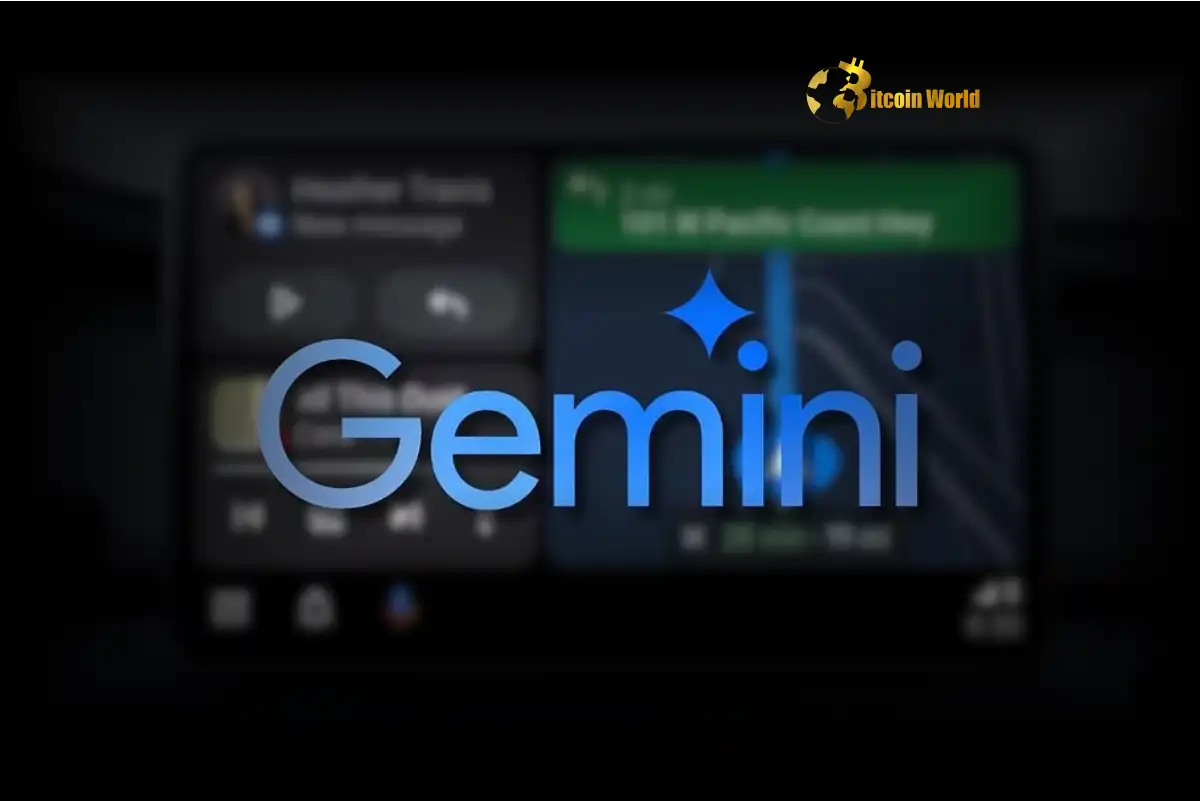Google Gemini Transforms Android Auto Driving Experience
0
0

In the rapidly evolving world of technology, where advancements in artificial intelligence are capturing global attention, Google is making a significant move by integrating its cutting-edge Google Gemini generative AI model into vehicles. For many in the cryptocurrency and blockchain space, keeping an eye on major tech shifts like this is crucial, as AI infrastructure often intersects with distributed computing and decentralized networks. This integration promises to redefine the in-car experience, making driving more intuitive and connected than ever before.
What is Google Gemini Bringing to Android Auto AI?
Google recently announced its plans to bring Google Gemini to cars supporting Android Auto within the next few months. This move, revealed ahead of the company’s 2025 I/O developer conference, signifies a major transformation in how drivers interact with their vehicles’ infotainment systems. According to Google, adding Gemini functionality to Android Auto, and later to cars running Google’s built-in operating system, will make driving “more productive and fun.”
Patrick Brady, VP of Android for Cars, described this as one of the most significant changes to the in-vehicle experience in a long time. The integration of Android Auto AI powered by Gemini will manifest in two primary ways:
- Enhanced Voice Assistant: Gemini will serve as a much more capable voice assistant. Users (drivers or passengers) can issue commands for tasks like sending texts, playing music, or getting directions, similar to the existing Google Assistant. However, Gemini’s natural language processing capabilities mean users won’t need rigid, specific commands. They can speak more conversationally.
- Contextual Understanding: Gemini can retain context and remember user preferences. For instance, it could remember a contact prefers texts in a certain language and handle the translation automatically.
- Advanced Information Retrieval: A common in-car tech request is finding points of interest along a route. Gemini will excel here, capable of mining Google listings and reviews to answer specific queries, such as finding “taco places with vegan options” nearby.
Exploring the Potential of In-car AI with Gemini Live
Beyond standard voice commands, Google Gemini will introduce “Gemini Live.” This feature allows the AI to be essentially always listening and ready to engage in more open-ended conversations. This aspect of In-car AI pushes the boundaries of what’s possible:
- Open Conversations: Users can discuss a wide range of topics, from brainstorming travel ideas for a trip to getting recipe suggestions or even discussing historical facts.
- Interactive Experience: This moves beyond simple command-response to a more interactive and engaging digital companion within the vehicle.
While the idea of an always-listening AI might raise questions about distraction, Google claims Gemini’s natural language abilities will actually reduce cognitive load by making interactions smoother and requiring less mental effort to formulate commands. This is a notable claim in an industry where some users are requesting a return to physical controls over complex touchscreens.
Addressing Challenges and Future Possibilities for Generative AI in Vehicles
Implementing advanced Generative AI like Gemini in a dynamic environment like a car presents challenges. Initially, Gemini will rely on Google’s cloud processing for both Android Auto and cars with Google Built-In. However, Google is collaborating with automakers to integrate more compute power into vehicles, enabling Gemini to run at the edge. Running AI models locally can improve performance and reliability, crucial factors in a moving vehicle that might experience inconsistent network connectivity.
Modern cars also generate vast amounts of data from sensors, cameras, and other systems. The potential for AI in cars to leverage this multimodal data is significant. While Google hasn’t made specific announcements yet, the company acknowledges the potential use cases, particularly with the increasing number of cameras in vehicles. This could lead to future features that are currently only theoretical.
Who Gets Google Gemini and When?
The rollout of Google Gemini on Android Auto and Google Built-In will extend to all countries where Google’s generative AI model is currently available. The service will support more than 40 languages, ensuring broad accessibility for users worldwide.
This integration marks a significant step in bringing sophisticated AI capabilities directly into the daily lives of drivers. As AI technology continues to advance, its presence in commonplace devices like car infotainment systems highlights the broader trend of AI becoming increasingly embedded in our physical world, a trend that has interesting parallels and implications for the development of decentralized technologies and the infrastructure that supports both AI and blockchain.
In conclusion, Google’s introduction of Gemini to Android Auto is set to dramatically change the in-car user experience. By providing a more natural, intelligent, and conversational interface, this Android Auto AI aims to make driving more efficient and enjoyable. While challenges related to processing power and data utilization are still being addressed, the potential for future enhancements using vehicle data is substantial. This move underscores the growing importance of Generative AI and In-car AI, pushing the boundaries of what we expect from connected vehicles.
To learn more about the latest AI market trends, explore our article on key developments shaping AI Models future features.
0
0
 Manage all your crypto, NFT and DeFi from one place
Manage all your crypto, NFT and DeFi from one placeSecurely connect the portfolio you’re using to start.





